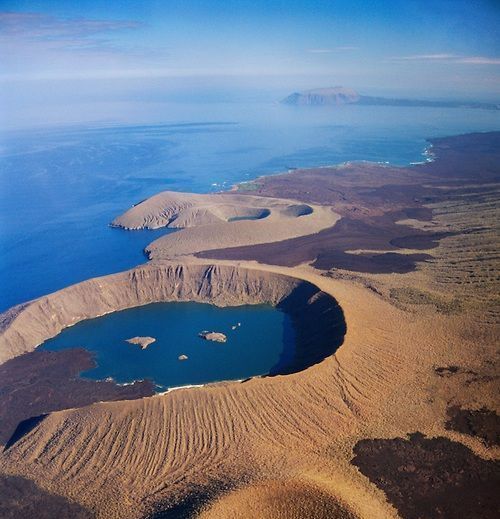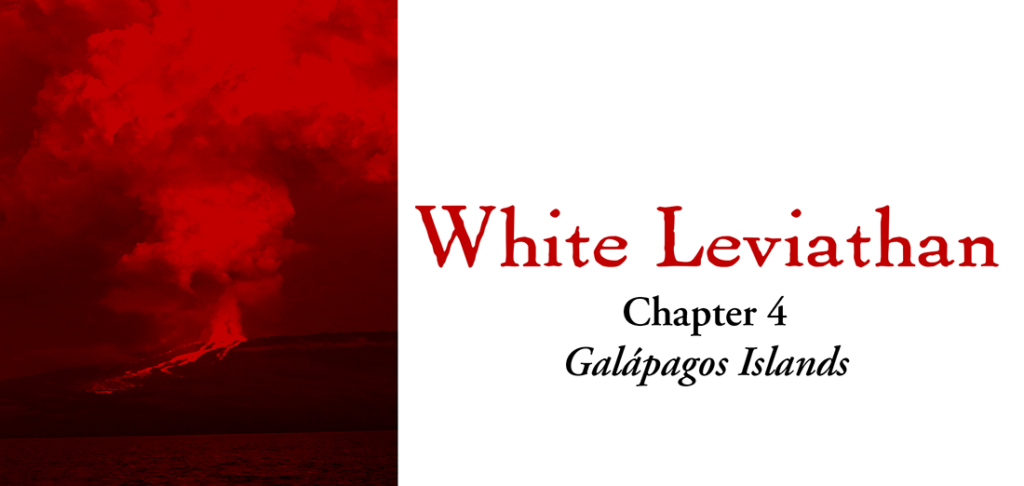Galápagos Islands: Tarnmoor’s Lagoon
- At November 16, 2022
- By Great Quail
- In White Leviathan
 0
0
8) Tarnmoor’s Lagoon
Albemarle Island, June 25, 1845
A) The Flooded Cone
Another littoral cone rises above the shore south of Banks Cove, a mile-long ellipse flooded with seawater to a depth of 500 feet. Known today as Beagle Cone, since Salvator Tarnmoor settled in the region in 1841, locals have referred to the crater as “Tarnmoor’s Lagoon.” The Quiddity sailors are likely to visit the area during their first day of turpining. While the steep walls of the cone may be climbed, it’s easier to approach the lagoon from the collapsed side adjacent the island’s shore.
 Beagle Cone with Tagus Cove to the north. (Unattributed on Pinterest.)
Beagle Cone with Tagus Cove to the north. (Unattributed on Pinterest.)
The Wooden Crown
A Spot Hidden roll made while traversing the cone discovers a strange object half-buried in the palagonite ash—a crown made from gold-painted wood and paste gemstones. It was created for a production of Richard III mounted by a company of British whalers, and later stolen by Rafael Castro. It has no intrinsic value, but if returned to Castro, earns his immediate gratitude (see Encounter 11).
B) The Shore
The saltwater lake is dotted with a few small islands—flat, cindery platforms covered with saltbush. A tent-like structure occupies the largest island. A battered dinghy is moored on the shore, covered by a tarp weighed down with clinkers. A substantial woodpile next to the boat is marked with a sign—“Property of Salvator R. Tarnmoor. Will trade wood, fresh vegetables & terrapin oil for sundry valuables, incl. spices, candles, books & gunpowder.” (Handout: Tarnmoor’s Sign.)
C) Tarnmoor’s Island
The boat is badly warped, and some amount of bailing is necessary to row the half-mile to Tarnmoor’s Island. The hermit’s tent is surrounded by a garden—a moat of transported soil protected by a low wall of volcanic rocks. Despite the promise of his sign, Tarnmoor’s “fresh vegetables” are restricted to a cluster of onions, some bedraggled tomatoes, and a dozen malnourished pumpkins. His attempt to cultivate an herb garden has produced questionable results, although he’s managed to grow some hot peppers of surprisingly decent quality. A pyramid of tortoise shells is stacked near the pumpkin patch, where a Dutch oven and a small trypot are used to render tortoise oil. A flagpole has been erected near the entrance of the tent. A flap of painted canvas flutters from the top, but whatever nation Tarnmoor has declared has been faded by the sun—there seems to be crossed harpoons? Three half-moons? Maybe a red dog? A cluster of water kegs surrounds the flagpole, all empty and bone dry. Indeed, the island appears to be in the early stages of abandonment.
D) The Tent
A work of some ingenuity, Tarnmoor’s tent is fashioned from a spanker sail supported by a splintered topgallant mast and braced by wooden planks and barrel staves. The interior is furnished from flotsam and jetsam. A wooden chain reel serves as a table, its chairs fashioned from tortoise shells, wicker, and netting. A hammock is suspended from a framework of oars and tarred hemp, while an upturned sea-chest serves as cupboard. Along with several metal pans, a wooden cup, and some tarnished silverware, the chest features several books—mostly Shakespeare and Milton, but a water-stained copy of James Colnett’s A Voyage to the South Atlantic and Round Cape Horn into the Pacific Ocean has seen hard use. A leather football rests atop the chest. It’s been painted with manic “googly eyes” and a crooked smile, and is topped by a saltbush wig. A ship’s lantern filled with tortoise oil hangs from the central mast, which also supports a rusty, two-flued harpoon. A Spot Hidden roll finds a name carved into its hickory pole: S.R. TARNMOOR.
Explorers entering the tent are welcomed by an inhuman hissing. A black iguana glares at them from the cupboard. It drops to the floor, knocking over a porcelain washbasin and scurrying awkwardly through a tear in the tent floor.
E) Salvator Tarnmoor’s Journal
Anyone investigating the garden is allowed a Spot Hidden roll. A success finds a tortoise shell half-buried in the cindery soil. The shell conceals a small box protected by oilcloth; inside is a moldering journal, three pens, and a bottle of ink. According to a faux bookplate elaborately sketched on the first page, the journal belongs to one Salvator R. Tarnmoor, a harpooneer from the Acushnet, a whaler out of New Bedford. Tarnmoor has been living on the island since 1841, trading tortoise oil and wood with passing whalers. Surprisingly literate for a boatsteerer, Tarnmoor spends much of the journal describing the Galápagos’ hellish landscape and engaging in occasional flights of fancy. (Handout: Tarnmoor’s Journal.)
Making Sense of Tarnmoor’s Journal
A targeted Library Use roll or a few hours of casual reading finds no mention of Mocha Dick, but does suggest that Tarnmoor is somewhat paranoid. A few entries indicate that Tarnmoor believed he was being watched, and he occasionally wonders if the iguanas aren’t actually “imps of darkness” sent to bewitch him. He writes about hearing “a nocturnal muttering, a distant thread of broken Spanish syllables,” and believes someone was regularly poaching from his garden when he was away from the island. The journal’s last entry is uncharacteristically short, and indicates that Tarnmoor and his dog Pilot recently set off for the “northern volcano.”
F) Joab’s Reaction
If Tarnmoor’s harpoon is shown to Captain Joab, he examines it scornfully—“The iron is rusted and unbent—untempered by the hot blood of the ‘snowy abomination.’ Any soul who slew the White Whale would prize the fateful iron as a trophy above all others. Ha! The man is a liar!” The harpooneer’s fanciful journal only provides more evidence that Tarnmoor is “a spinner of tall tales.” Nevertheless, if Joab needed any convincing to support the Lowell Expedition, the thought of contacting the isolato tips the scales.
White Leviathan, Chapter 4—Galápagos Islands
[Back to Encounter 7, Banks Cove | White Leviathan TOC | Forward to Encounter 9, The Lowell Expedition]
Author: A. Buell Ruch
Last Modified: 26August 2023
Email: quail (at) shipwrecklibrary (dot) com
White Leviathan PDF: [TBD]

